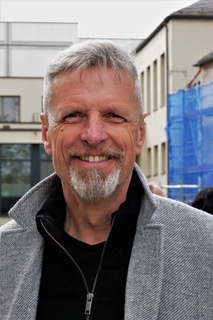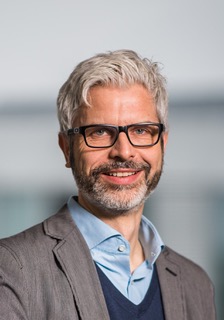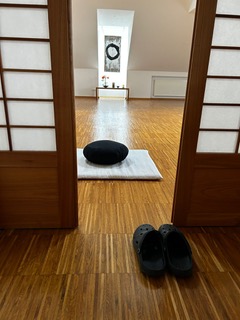

Reality
When something real happens: in the Lab and in Zen
Two people take their seats. They are concerned with reality. Both believe that when we are distracted, when ‘things’ happen inaccurately, reality is not accessible to us. They seem to come from very different backgrounds and operate in very different contexts: a scientist in the laboratory, a Zen master in the zendo. They also seem to proceed differently: One wants to make the subjective disappear in order to advance towards an objectivity that everyone can comprehend. The other seems to leave behind the distinction between subject and object, which is actually only a construct, in practice. But don’t they both make an effort to allow reality to happen and to notice this happening with the closest attention?

The Practice of the Experiment (the Neuroscientist)
“There are only two ways to live your life. One is as though nothing is a miracle. The other is as though everything is a miracle.” Albert Einstein
A typical day in the life of an experimental scientist begins at the desk, perhaps with a coffee cup in hand. After reading the latest research abstracts, sometimes multi-page publications and drafts from your own lab and from colleagues, after dealing with the initial correspondence, you head “over” to the lab. There, the medium in the cell culture may need to be changed: The replication and cell cycle of culture cells knows no weekends or holidays, and with a maximum tolerance of 12 hours, everything must be standardized and ritualized, i.e. carried out exactly in such a way that optimal and meaningful results can be obtained later in the experiment or in the analysis afterwards. This applies to all agents and processes: the “art” of the experiment lies in always doing everything exactly as described, tested and replicated, so that the human factor – the individual with their subjective interests and goals, their “ego” – has as little influence as possible on the processes generated. Every experiment should be able to be reproduced and repeated by knowledgeable third parties. The unknown that the experimental process can ideally produce is the interesting variable. If things go well, something previously inaccessible is the “result” of the analysis and ultimately leads to a newly gained insight. Depending on how new (i.e. unknown, deviating) what appears in the experiment is for the people in the laboratory, they will be more surprised, more amazed, more pleased about the aspect of reality that has now come to light. And the more verifiably standardized and ritualized the experimental procedure is, the more reliably one can “believe” a previously unknown deviation as a result in which reality has been discovered. This always requires several attempts (the first ones are always discarded) until you can “really trust” that standard and the processes behind it. Through iterations, this standard becomes more and more robust. The newly discovered aspect of reality becomes clearer and clearer, the results become more and more unambiguous and ideally more comprehensible. It is as if a process has been found in which something hidden behind a larva can be unmasked, or more soberly: an experiment that reveals something new has become replicable. The new is now accessible to everyone.
Frankly, and from personal experience: can the individual, human factor (the second or first person) always be safely excluded when experimenting? Experience has shown that the form of the day, the biorhythm, the time of day and the season can all have an influence. The person carrying out the experiment (if a person) and any “unknowns” – be it an expired or contaminated chemical or even just a slightly chemically modified buffer solution – can lead to something not working, something not being right, and the “exactly-like-this” remains an illusion. The independent third person (lab technician, evaluator, describer) or the second person participating and observing (in the lab or at the computer in the office), and finally the perspective of the “to-be-examined” – none of this can always be reliably separated. And then you start again from the beginning, restart the whole experiment, reapply all the agents, ask the same or a modified question. You start with yourself, then in triangulation, finally in a team or in discourse with the entire relevant research community, with meetings and conferences in between. And lots of numbers and letters: Syntax and semantics, significances, signs and interpretations (semiotics). Everything is in flux. Will it be possible this time to clearly distinguish the subjective from the objective? Is the laboratory therefore a place of knowledge where attempts are made to reveal the reality that is constantly unfolding without us, through ritualization, standardization and repetition, through a “dehumanization” of processes, so that we see how it is?
(Tobias Esch)

The Practice of Meditation
“People try to achieve something even in zazen. Even on the Buddha’s path, they stress themselves out.” Kodo Sawaki
What do I do when I practice Zen? Answer: Nothing special. Unless walking while I walk, sitting while I sit or eating while I eat is considered special and labeled ‘meditation’.
To begin with, I would like to point out that, contrary to popular belief, the term ‘meditation’ no longer allows for a clear designation and classification. Especially in recent decades, it has been used for numerous and very different practices and techniques that are embedded in a wide variety of worldview contexts. The standardized term ‘meditation’ for sometimes contradictory practices and the narratives associated with them can easily lead to the assumption that all these groups and practices, despite all their differences, are pursuing a common goal. But this is not the case. Unfortunately, or fortunately. As a rule, the opposite is in fact the case, so that we would be well advised to first understand the specific practices in the context of their own narrative. This also applies to Zen and the practice of zazen, which is often referred to as Zen meditation or simply ‘mediation’, which can lead to the distortions and confusion just mentioned.
In fact, each of the moments that take place, be it one of walking, sitting, eating or anything else, when I am completely one with it, instantly embodies its own very special essence. That is all there is to it. That is Zen meditation. The unusual thing is that I typically assume that my ‘self’ as an independently existing subject is separate from the action and its goal. That’s why it has to be ‘I’ who always has something to do, even if this action is a ‘meditation’ with the goal of “being with myself”. For my ‘self’, the division into subject (I), object (goal), verb (action) is the most natural representation of an objectively existing reality. It is precisely this assumption that Chan or Zen questions. However, they do not want to do it theoretically, but rather practically, through an experienced insight. Because this is a fundamental insight into the nature of our reality, it can be practiced at any time and in any place. Meditation, understood and practiced as a “to”, is counterproductive under these circumstances.
Therefore, the “goal” of Zen is neither the achievement of something by someone, nor the associated practice. Rather, it is about becoming aware of the nature of so-called reality, in which the difference between the striving subject and the objective state to be achieved does not exist. It is about behavior that arises “of its own accord” from this awareness. Classical Chan therefore does not have an explicit method. Quite the opposite. Methods are targeted procedures to be applied by subjects. It is not even necessary to do anything special. It is enough if I carry out what is happening more precisely, i.e. more consciously, in order to see how it is happening. And how does it happen? Despite the common but probably inaccurate assumption, it turns out that there is nothing that exists separately, independently or on its own, but that everything always appears only as an interaction: neither subject nor object are in themselves, but exist only as aspects in the moment, related to each other, thus appearing in an event that is not controlled by an ego.
The simplest action that both enables and expresses this awareness is called ‘zazen’ in the Chan and Zen tradition, which means “just sitting”. How does zazen happen? As I enter the room for zazen while awake, I slowly stop following all my thoughts. Entering the room (Japanese: zendo) and walking (Japanese: kinhin) to the seat, for example, develop from what they are in my current perspective, more to what they actually are, namely means and goal in one. I enter the zendo with my hands joined together (Japanese: gassho), signaling “being present” to my otherwise rather scattered mind. Step by step, the movement towards the seat cushion follows, during which I become more and more the embodied walking, which means nothing other than that I literally let myself go. By this I mean the fact that my consciousness is less and less distracted by what is not happening right now, but that can be thought and imagined. When I arrive at my seat, I sit down at a natural speed. Sitting is not really done by me or a ‘self’ that exists within me. I can become more and more aware of this over time. It is the surrendering to two interacting forces: gravity, which grounds the body, and sitting upright, which keeps it and, noticeably, the consciousness awake. That is all there is to it. All this also reoccurs in daily life, but it is easier to see as zazen because it is embodied directly and without any other “inputs”.
And what do I do? Nothing. I just sit while sitting. I am content with sitting as ‘sitting’. My mind is at peace, not because it has achieved something, but because it is fully awake and wants nothing other than what is happening right now. Contentment is an event in which the subject-object-verb perspective and the striving associated with it no longer (or: not yet) take place: Experienced, because accomplished awake sitting. The spirit of origin. This is probably the most important difference to the so-called everyday attitude, in which the almost exclusive identification with the contents of consciousness of whatever kind gives rise moment by moment to the subject-object-predicate perspective and with it the feeling of duality, separation, absence, wanting and striving and the many fears. In other words, every conscious experience, zazen, in its simplest and most immediate form, offers the opportunity to “awaken”. This refers to the experienced insight into the nature of reality, when it becomes clearer immediately, because it is “experienced”, in what quality consciousness and thus the reality possible to us is embodied from moment to moment.
And what happens now? The gong sounds. The zazen is “over”. Instantly thoughts give rise to the ‘I’ (subject) in relation to the toilet (object), to which I must go more quickly (verb) so that everything is in order. Everyday life? Yes. Every-day. Everything as usual and yet completely different.
(Alexander Poraj)
Isn’t it strange that countless things happen all the time without “us” noticing? Isn’t science an attempt to better notice and understand what is happening? Isn’t Zen meditation the practice in which we completely abandon ourselves to what is happening, even disappear into it? Aren’t enlightenment, awakening, wisdom all words for this attitude: “Don’t fool yourself!” “See it for what it is!”
Hilf uns dabei, eine weltumspannende Collage an Erfahrungsberichten zu Weisheitsthemen zu sammeln und miteinander ins Gespräch zu bringen.
Die Erde ist eine Scheibe. Zwei mal zwei macht vier. Viren gibt es nicht. Zucker kann Karies verursachen. Die Wirtschaften der Welt werden von einer unsichtbaren Hand zum größtmöglichen Glück aller gelenkt.
Wahrheiten und Unwahrheiten bestimmen unser Leben. Welche Wahrheiten sind überhaupt relevant? Welche Illusionen gefährden eine gelungene Lebensführung?
Der Tod ist groß.
Wir sind die Seinen
Lachenden Munds.
Wenn wir uns mitten im Leben meinen,
wagt er zu weinen
mitten in uns.
Liegt im Dao das Gute Leben verborgen? Wo muss ich es dann suchen? Was ist das Dao überhaupt?




